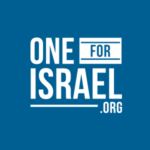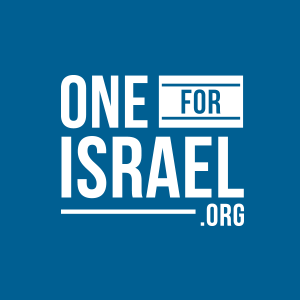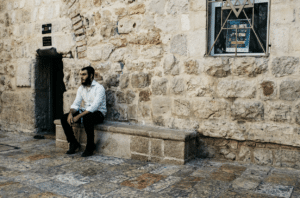Some are now calling the keffiyeh a “hipster swastika”, which might seem a little extreme, but it’s worth looking into both the protests and symbolism behind their choice of garb. Those likening the Palestinian-style headdress to the nazi symbol suggest the keffiyeh now carries the same connotations of Jew-hatred. Is that fair? What are the origins of that headdress? Like the Palestinian flag, the keffiyeh has some interesting history, but it has become loaded with meaning lately.
The background of the keffiyeh
Bedouins have been wearing the traditional Arab headscarf with its circular rope to bind it from time immemorial. It’s not new. A keffiyeh provides good protection from the harsh desert climate, from sand and sun, and has become standard around the Middle East, much as a suit and tie has in the West. The name keffiyeh is thought to derive from the city of Kufa in Iraq in the seventh century. However, the headscarf has different names in different areas of the Middle East, and comes in a variety of styles. Men in the Gulf states more commonly wear a plain white keffiyeh, while the king of Jordan usually wears a red one. And how about that black and white one?
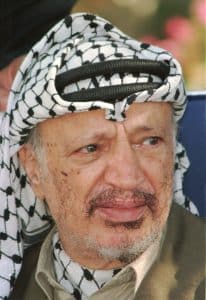
The iconic image of Yasser Arafat in a black and white fishnet keffiyeh has become a symbol of Palestinian resistance.
But that keffiyeh is as Palestinian as Yasser Arafat, which is to say, not very.
Arafat was an Egyptian: by name, by lineage, by birth, and even by admission. Farid Georges Kassab, an Orthodox Christian from Beirut, was the first Arab recorded to use the term “Palestinian”. In his book from 1909 he wrote, “the Orthodox Palestinian Ottomans call themselves Arabs, and are in fact Arabs.”1 Using the term Palestinian to describe people only began in the middle of the twentieth century, and for reasons of gaining political leverage over the already established Israel.
The keffiyeh then is not exactly Palestinian, but historically has long been a recognizably Arab garment. There are, however, different styles and colors which have meaning and tell a story. The story behind the black and white keffiyeh is similar to the story of the Palestinian flag: it’s ironically down to an Englishman, back in the time of the British mandate.
John Bagot Glubb had been a Lieutenant General in the British armed forces before founding the Arab Legion that later became the Royal Jordanian Army. The red and white keffiyeh was traditionally worn by Jordanian Bedouin, but Glubb needed a way to distinguish between them and the soldiers from Palestine under his command. So he came up with a black and white alternative.
The Sudra: the Jewish headdress
Even older than the Iraqi keffiyeh from the seventh century is the Israelite sudra (sometimes known also as the sudar), which is the version worn by Jews in ancient Israel. And you know where that is mentioned? In the Gospel of Luke! That means the sudra was around two thousand years ago, in the time of Jesus. Jesus Himself mentions the sudra in the parable of the talents:
The first came before him, saying, ‘Lord, your mina has made ten minas more.’ And he said to him, ‘Well done, good servant! Because you have been faithful in a very little, you shall have authority over ten cities.’ And the second came, saying, ‘Lord, your mina has made five minas.’ And he said to him, ‘And you are to be over five cities.’ Then another came, saying, ‘Lord, here is your mina, which I kept laid away in a handkerchief [sudra]…” (Luke 19:17-20)
This last word here, translated as handkerchief or piece of cloth, is sudra in Greek (σουδαρίῳ – soudariō).
That’s right, Jesus talks about the sudra in the parable of the talents.
The sudra looks similar to the keffiyeh in many ways—a piece of cloth wrapped around the head as a protection from the elements, and for dignity. Rudy Rochman, a prominent Jewish activist, explains that the sudra is a native Judean headdress and has been a part of Israelite culture for thousands of years. The traditional skullcap worn by Jewish people today is apparently a minimized sudra that Jewish people could hide in order blend in with the societies they were living in. The website MySudra explains the development like this:
“Due to the persecution [Jewish people] faced and assimilation they endured, the Sudras over time were minimized into smaller head coverings that could be hidden under hats, making Jews less noticeable in foreign lands. These head coverings today can be recognized and commonly referred to as “kippas” or “yamakas”. Jews with North African & Middle Eastern diasporic experiences were often forced to remove the Sudras off of their heads as they were “dhimmis” and could no longer wear them as second class citizens.”
Rudy Rochman believes that wearing his sudra is a way of quietly demonstrating the indigenous nature of the Jewish people and their connection to the land of Judea, saying, “This world will once again know it to be a normal part of a decolonized Israelite reality”.
Colonizer or colonized?
The protesters wrapping keffiyehs around their faces decry Israel as a racist, colonial project. But the very scarf they wear testifies to the opposite. There was no autonomous Palestinian state to colonize, but rather the vestiges of the Turkish colonialist enterprise that had crumbled. The Middle East was divvied up and given back to all the indigenous peoples that had previously been ruled by the Ottoman Empire. This included Syria, Lebanon, and Jordan, as well as what would become the reborn state of Israel. They were being liberated from the colonial power of Turkey to become autonomous states.
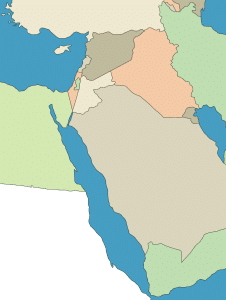 Muhammad Y. Muslih, a Palestinian historian, affirms that during the 400 years under the Ottoman Empire, before the British Mandate, there was no political unit known as Palestine. Here’s how he described it in his work The Origins of Palestinian Nationalism:
Muhammad Y. Muslih, a Palestinian historian, affirms that during the 400 years under the Ottoman Empire, before the British Mandate, there was no political unit known as Palestine. Here’s how he described it in his work The Origins of Palestinian Nationalism:
“Before the end of World War I, Palestine formed part of the Ottoman Empire. Under the Ottoman regime (1517-1918), there was no political unit known as Palestine. In fact, the country was better known by its Arab-Muslim name of al-Ard al-Muqadassa (the Holy Land). Palestine was also referred to as Surya al-Janubiyya (Southern Syria), because it was part of geographical Syria, namely the land mass that incorporated present-day Syria, Lebanon, Palestine, and Transjordan.”2
Palestine has historically been the name of an area, like the Levant, or Mesopotamia. The term was used to describe everyone, of whatever ethnicity, living in the area of Palestine. There were Palestinian Jews and Palestinian Arabs, but there were no ethnically Palestinian people—rather, the Arabic speakers of the land were Syrians, Bedouins, Druze, Arameans, Maronites, Egyptians, Arabs from Transjordan, and other neighboring areas. Some of these families have lived in the land for generations, even back to the time of Jesus. Others arrived when more prosperity and infrastructure started appearing around the time of the British Mandate.
An important point to make here is that the term “Arab” can be confusing.
Arabs are not necessarily those from Arabia, but the term “Arab” in the Arabic language literally means one who speaks Arabic. That includes an awful lot of people. The reason there are so many Arabic speakers is because of colonization.
Mohammed and his relentless wars of jihad saw to that from the seventh century onwards. A huge number of people—Jews, Christians, Zoastrians, Egyptians, you name it—were forcibly converted to Islam and to speak Arabic.
What would have happened if Israel lost in 1948?
You’ll often hear that this war didn’t start on October 7th but in 1948. The establishment of the state of Israel is seen by some as a travesty, a catastrophe. But let’s imagine what might have happened if the five Arab armies that attacked the new state had won, and Israel had lost that war. Would Palestine be a free state, with all its borders in tact? Not even remotely. The Arab army, remember, were not Palestinian but Jordanian, Egyptian, Syrian, and Iraqi. They would have divided the land between themselves. The key concern was maintaining Islamic sovereignty.
Abdel Rahman Azzam, first secretary-general of the Arab League, told a British reporter that the plan was for Transjordan “to swallow up the central hill regions of Palestine with access to the Mediterranean at Gaza”. He candidly admitted that “The Egyptians would get the Negev. The Galilee would go to Syria, except that the coastal part as far as Acre would be added to Lebanon.”3 In other words, the land would be divvied up to the neighboring Arab Muslim countries. There was no plan to create an autonomous state of Palestine. It would not have been “free”. It would just have been occupied by neighboring Muslim countries instead.
During the British Mandate, the Peel Commission tried to find a solution to satisfy both Jews and Arabs living in Mandatory Palestine, proposing a partition plan. This was roundly rejected by the Arab Higher Committee in 1937 who explained: “This country does not belong only to Palestine Arabs but to the whole Arab and Muslim Worlds”.4
We see that same mentality today in Hamas. A Senior Hamas leader also said, “This…land…is not the property of the Palestinians…. This land is the property of all Muslims in all parts of the world.” ~ Mahmud Zahar, 1996.
The inverted reality of the pro-Palestinian protests
These protests have revealed a great deal of upside-down thinking, and the worldview that the keffiyeh now represents has become a complete inversion of the truth. As they say, when you point the finger, there are three fingers pointing back at you. Well that’s the surreal situation we’re seeing in the protests around the globe: the furious keffiyeh-clad protesters are supporting a terror organization guilty of the exact crimes for which they’re condemning Israel.
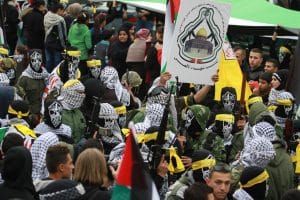 Some of the Palestinian keffiyeh scarves seen sported by PLO dignitaries have a design of the Al Aqsa mosque with the declaration “Jerusalem is ours”. This is the reason they rage. It’s not western-style freedom they want, it’s Muslim control of Jerusalem and the whole of Israel: God’s real estate. That’s not to say the people themselves don’t want freedom, of course many do. Many just want peace. But the drive to subjugate the entire area of the Levant, of historic Palestine, back under Islamic control is strong. Sadly we have seen it’s not just the leaders who are pushing for it and willing to sacrifice for it, but it seems the majority in Gaza and the West Bank feel the same way.
Some of the Palestinian keffiyeh scarves seen sported by PLO dignitaries have a design of the Al Aqsa mosque with the declaration “Jerusalem is ours”. This is the reason they rage. It’s not western-style freedom they want, it’s Muslim control of Jerusalem and the whole of Israel: God’s real estate. That’s not to say the people themselves don’t want freedom, of course many do. Many just want peace. But the drive to subjugate the entire area of the Levant, of historic Palestine, back under Islamic control is strong. Sadly we have seen it’s not just the leaders who are pushing for it and willing to sacrifice for it, but it seems the majority in Gaza and the West Bank feel the same way.
And now they have drawn multitudes of impressionable and eager activists from the West into their battle to reconquer. There will be a huge number protesting who only mean well, who are just responding to the images of innocents dying and in need, and the idea of people living under oppression. The situation is very complex and the optics are not good. The truth about the lengths Israel goes to in order to protect innocent Palestinians is often drowned out, sidelined or censored. Reports from Hamas are believed and reported as fact while Israel’s word is constantly doubted and questioned. The outrage is understandable, but many have pointed out that this outrage seems reserved only for situations involving Israel. And in their fury they cannot see the irony of their actions:
They’ve turned campuses into battlegrounds, even as they demand a ceasefire.
They scream about genocide while supporting Hamas, who have genocide as part of their charter.
They bully and exclude Jewish students, denying them entry because of their race… while accusing Israel of apartheid.
They rage against expressions of nationalism in the West, yet wave Palestinian flags while shouting about land and borders.
They talk about innocent blood while defending Hamas who deliberately murdered, burned, and tortured children.
They accuse Israel of colonialism while effectively supporting a return of an Islamic caliphate to rule the entire region.
Sadly the keffiyeh has got wrapped up in the chaos, and has almost become emblematic of this demonic insanity.
The keffiyeh, the sudra, the talit, and the tent
It’s foolishness to think we can divide God’s children into “goodies” and “baddies”. That kind of thinking degenerates into extremely unhelpful dynamics very quickly. We’re all sinful before God, and we all stand in desperate need of redemption, Jew and Arab alike. However God does have a plan, and opposing it is not a good idea. Collaborating with the unseen enemy is the real danger: falling into his traps of twisted hatred and lies.
God’s heart is full of love and life. He is truth. He is peace. He is reconciliation.
Instead of seeing two sides, God sees two sons. We need two lenses to see what God sees, and love as God loves.
The keffiyeh is not “bad” in itself, even if people running errands for Satan may be wearing it right now. It’s just a scarf. Perfectly innocuous items can become laden with negative meaning but it doesn’t mean that they themselves are bad. Consider the rainbow for example, and even the cross. It has been said that the cross has such bad associations in the Jewish mind (due to the rampant persecution of Jewish people in the name of the church over the centuries) that it has a similar effect to the swastika. It has become repellant. And you can clearly see that the cross is not only innocuous but powerfully good. So unhinge the keffiyeh from the demonic overtones of the mob and remember that it represents God’s beloved children, just as the Jewish sudra does. Not only is there a shared love of headwear and hummus, but research over the last decades has proved that the genes of Jews and Arabs in the region are also intertwined.5 We are, after all, family.
Ishmael was sent away from the family home when he mocked Isaac, the chosen child. The wound of rejection is deep. Abraham is the father of all these people groups, and God, our Heavenly Father, loves us all. God chose Isaac for His purposes, but just as Abraham loved both sons, God loves all His children and invites everyone to come under His canopy, into His tent, whether they’re wearing a keffiyeh or a sudra. The keffiyeh, the sudra, the talit (Jewish prayer shawl) and the tent… these are all fabric items of covering and shelter. Today the God of Abraham, Isaac, and Jacob is still sending out the invitation to come home—but it has to be under His covering and on His terms. The tent of father Abraham is open to all. If we could go back and see it in his day, we’d probably see Abraham, a nomad of the desert, coming out of his tent with a scarf wrapped round his head.
- The Times of Israel, The Invention of the Palestinian People, Alan Meyer, August 9, 2019
- Muhammad Y. Muslih, The Origins of Palestinian Nationalism, (Columbia University Press, 1988) p.11
- Efraim Karsh, Palestine Betrayed, Yale University Press; American First edition (April 27, 2010), Chapter 10
- Middle East Forum, Palestinian Leaders Don’t Want an Independent State, Efraim Karsh, Summer 2014
- HaAretz, Blood Brothers: Palestinians and Jews Share Genetic Roots, Josie Glausiusz, October 20, 2015
